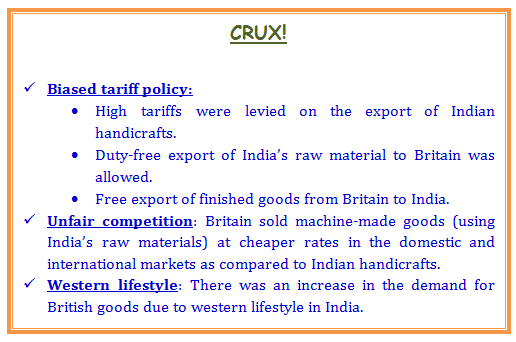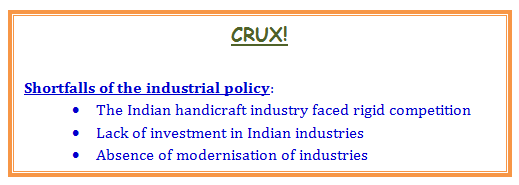Class 12-science NCERT Solutions Economics Chapter 1 - Indian Economy on the Eve of Independence
Indian Economy on the Eve of Independence Exercise 14
Solution 1
The main focus of economic policies pursued by the colonial government was to serve the economic interests of the home country rather than those of India. They exploited India by using it as a supplier of raw materials and a consumer of British-made finished goods.
Impacts of these policies are discussed below:
- Backwardness of the agricultural sector: The Indian economy under the British rule was in a stagnant and backward state. The reason for this was various land settlement systems which were implemented by the colonial government. One among them was the zamindari system. Under this system, cultivators used to pay a very high amount as rent to the zamindars. Out of that rent, the zamindars used to pay a certain specified sum of money to the British government on a particular date. However, neither the colonial government nor the zamindars made any attempt to improve the condition of cultivators. They did not pay attention to developing the agricultural sector, hence; it remained underdeveloped during the colonial government. In addition, commercialisation of agriculture, i.e. production of cash crops instead of food crops further worsened the situation in the sense that India faced a shortage of food grains.
- Deindustrialisation: India could not develop its industrial sector under the colonial rule. This is because the colonial government followed the policy of systematic deindustrialisation. Under this policy, India was turned into an exporter of raw materials to Britain and an importer of British-made finished goods. Also, the colonial government imposed heavy tariffs on exports of Indian handicrafts which destroyed the handicraft industry in India.
- Poor growth of foreign trade: Under the colonial rule, India exported primary products such as raw silk, cotton wool, sugar, indigo and jute to Britain and imported finished consumer products such as cotton, silk woollen clothes and capital goods from Britain. Britain controlled the Indian foreign market in order to fulfill its economic interests. In this regard, more than 50% of India's foreign trading activities were with Britain and the remaining trading activities were with China, Sri Lanka and Iran. The control of Britain over India's foreign trade was further increased with the opening of the Suez Canal. Hence, the result was poor growth of foreign trade during the colonial period.

Solution 2
Notable economists who estimated India's per capita income during the colonial period:
- Dadabhai Naoroji: In 1873, Dadabhai Naoroji used simple but effective methods to calculate India's per capita income for 1867-68.
- William Digby: In 1889, William Digby estimated the per capita income as Rs 18 per person.
- Findlay Shirras
- V. K. R. V. Rao
- R. C. Desai
Among these economists, Rao's estimates were considered more significant.
Solution 3
Causes of India's agriculture stagnation during the colonial period:
- Land revenue system: The colonial government in India introduced various systems of land settlement. The zamindari system was one of the land settlement systems. Under the zamindari system, the zamindars were the owners of the land and used to collect rent from cultivators. They were also required to pay a certain specified sum of revenue to the colonial government. Despite using agricultural land as a source of income, neither the colonial government nor the zamindars made any attempt to improve the condition of the land. They did not pay attention to developing the agricultural sector, hence; it remained underdeveloped during the colonial government.
- High dependency on monsoon: The Indian agricultural sector was deprived of irrigation facilities and technology advancement. As a result, the production of the agricultural sector was solely dependent on the monsoon. This created an adverse situation for the farmers and led to a low level of agricultural productivity.
- Commercialisation of agriculture: To maintain the continuous cheap supply of raw materials from India, the colonial government forced Indian farmers to grow commercial crops such as indigo, tea and coffee instead of food crops. This resulted in the shortage of food grains and a dismal state of the agricultural sector.
Solution 4
Modern industries which were in operation during the second half of the 19th century:
- Cotton textile industries: These were mostly set up by Indians and were located in Maharashtra and Gujarat.
- Jute industries: These were mostly dominated by foreigners and mainly concentrated in Bengal.
- Iron and steel industries: These were set up in the beginning of the 20th century. The Tata Iron and Steel Company (TISCO) was established in India in 1907.
- Sugar industry, cement industry and paper industry: These were set up after the Second World War.
Solution 5
The following is the two-fold motive behind the systematic de-industrialisation effected by the British in pre-independent India.
- To make India a net supplier of essential raw materials to the British industries. The main motive of this move was to make India only an exporter of raw materials to British modern industries.
- To create a larger market for finished goods in India so that British industries could expand and grow.
Solution 6
I agree with the given statement that traditional handicrafts industries were ruined under the British rule. During the eighteenth century, the demand for handicraft products was high in both domestic and international markets. However, the policies introduced by the colonial government significantly reduced the demand for handicraft products.
Reasons for the devastation of handicraft industries during the British rule:
- Biased tariff policy: The colonial government followed a biased tariff policy in the sense that they levied high tariffs on export of Indian handicraft goods and allowed duty-free export of India's raw material into British markets. Also, Britain freely exported finished goods in the Indian market. Because of this, Indian handicrafts faced a tough competition from foreign goods and could not survive in the market. Hence, Indian handicrafts were ruined under the British rule.
- Unfair competition: Britain produced machine-made goods with the help of cheap raw materials from India. This enabled Britain to sell its machine-made goods at cheaper rates. The railways also helped in this regard as they carried goods to the remotest areas. Hence, the traditional handicrafts industry faced severe competition from machine-made British goods, and eventually, the demand for Indian handicrafts fell drastically because of comparatively low quality and high prices.
- Western lifestyle: The colonial government promoted western lifestyle in India which led to an increase in the demand for British goods. The ones who demanded British goods were mainly zamindars.
Solution 7
Infrastructure such as water transport, power, railways, roads, irrigation, posts and telegraphs were developed under the colonial rule. The objective of infrastructure development was not for the welfare of the Indian economy but to serve its own economic interests. The following points elaborate the objectives which Britain intended to achieve through the policies of infrastructure development in India.
- Roadways: Roads were built to mobilise the army from one place to another and to draw out raw materials from the countryside to the nearest railway station or ports.
- Railways: In 1850, the railways were introduced in India which helped in the commercialisation of Indian agriculture. They also enabled movement of Britain-made finished goods to different places of India.
- Communication: Development of a modern system of communication such as the introduction of the telegraph aimed to control the law and order in the country. This facilitated the integration of different parts of India and helped to develop trade, commerce and industry.
Solution 8
The colonial government followed an industrial policy which made India a mere supplier of raw materials for the British industry.
Some of the shortfalls of the industrial policy pursued by the British colonial administration:
- Decline of the Indian handicraft industry: The colonial government did not develop the handicraft industry in India. The main motive of the colonial government was to serve its own economic interests. In this regard, they levied high export duties on the export of handicraft products. Also, the handicraft industry faced rigid competition from the machine-made textile industries of the British. This resulted in the downfall of Indian handicrafts.
- Lack of the capital goods industry: The Indian modern industries were in need of investments in capital goods. However, the colonial government did not show any kind of interest in investing in India. Hence, the growth and development of the Indian industry was significantly constrained because of a lack of investment in Indian industries.
- Lop-sided modern industrial structure: British rulers never encouraged modernisation of industries and the growth of heavy industries in India. During 1850-55, jute mills, cotton mills and coal mines were established for the first time.
Solution 9
The British rule in India is remembered for its destructive role. It lasted for about 200 years and was characterised by an organised exploitation of India's natural resources and wealth. The term drain of wealth was first used by Dadabhai Naoroji.
The trade policies adopted by the colonial government were mainly designed to promote its own economic interest and to exploit India's resources. The colonial government promoted free export of India's raw materials and duty-free import of British machine-made goods into India. This resulted in the generation of a huge export surplus, but it did not add anything to the wealth of the country (in the form of silver and gold). The net result of the policies during the British administration was large-scale open utilisation of India's resources. Indian resources were used to nourish the British industry. The huge surplus was used in the following ways:
- To cover the expenses of the new office set up in Britain
- To incur war expenses
- To meet the expenses on import of invisible items
Hence, it led to the drain of Indian wealth.
Solution 10
1921 is regarded as the year of great divide or the defining year to mark the demographic transition from the first to the second decisive stage. This is because of the stagnant population growth before 1921. In the first decisive stage till 1921, there was a high birth and death rate, i.e. a low expectancy rate. The higher death rate caused a dip in the growing population of India before the period of 1921. After 1921, there has been significant increase in the population because of a low death rate and higher birth rate in India.
Solution 11
Quantitative details of India's demographic profile:
- High birth rate and death rate: The birth rate and death rate were high during the colonial period. The birth rate was about 48 per thousand and the death rate was about 40 per thousand. This indicates that the population growth was stagnant because of the high birth rate and death rate in India. This shows that the country was backward.
- High infant mortality rate: The infant mortality rate refers to the death rate of children below the age of one year. The infant mortality rate was also very high, i.e. about 218 per thousand under the colonial period.
- Low life expectancy rate: The life expectancy rate refers to the number of years which a new born child on an average is expected to live. This rate was about 32 years. This indicated that India was socially backward during the colonial period.
- Mass illiteracy: Mass illiteracy among the people is considered an indicator to measure poverty and backwardness of the economy. The overall literacy rate was less than 16%, and the female literacy rate was only 7%.
- Low standard of living: During the colonial period, India had a very low standard of living and enormous poverty. People used to spend nearly 80% of their earned income on basic goods such as food and clothing. Also, many of the people were unable to get adequate food for their survival.
Solution 12
The occupational structure is the distribution of population engaged in various occupations. Salient features of India's pre-independence occupational structure:
- Agricultural sector: The prime occupation during the colonial government was farming. Under farming, approximately 70-75% of the population depended on the agricultural sector for their subsistence. There existed regional variation in the occupational pattern. States such as Tamil Nadu, Kerala, Andhra Pradesh, Karnataka, Maharashtra and West Bengal showed a declining trend of dependency on the agricultural sector. On the other hand, Punjab, Odisha and Rajasthan showed an increase in the share of work force engaged in agriculture.
- Manufacturing sector: Approximately 10% of the total population was engaged in the manufacturing sector during the colonial government. India had a well-developed industrial base before the British entry. However, the colonial government's unfair policies ruined the industrial sector of India.
- Service sector: Approximately 15-20% of the total population was engaged in the service sector during the colonial period.
From the above points, we can conclude that agriculture, industry and service sectors were not equally developed in India.
Solution 13
Most crucial economic challenges at the time of independence:
- Low level of agricultural productivity: At the time of independence, India was basically an agrarian economy with nearly 85% of its workforce involved directly or indirectly in agriculture. Massive poverty and a low literacy level forced a large proportion of population to engage in farming and related activities to earn their subsistence. However, the British government took advantage of the India's agricultural sector for its own profitability. Hence, India's agricultural sector was badly exploited and experienced stagnancy, a low level of productivity and a lack of investment.
- Slow progress in the industrial sector: Although India was popular for its handicraft industries such as cotton and silk textiles, it could not develop its industrial sector under the British rule. This is because India faced tough competition from the British industries and lacked capital, infrastructure and technology which were required for the development of the industrial sector.
- Poor infrastructure: There were no proper infrastructure facilities to impart technical knowledge to labourers and to develop trading and commerce in the economy. There was also a need to upgrade and expand the railway network.
- Poverty: The plight of the Indian population at the time of independence was poor as the colonial government used India's wealth for the development of its home country.
Solution 14
India's first official census operation was undertaken in 1881. Since then, the census operation is carried out every ten years. A census provides a complete estimation of the population size and demographic profile of the country.
Solution 15
Policies pursued by the colonial government adversely affected the volume and direction of foreign trade in the following ways:
- Policies made India an importer of final consumer goods such as silk, cotton, woolen clothes and other capital goods from British industries and an exporter of raw materials such as cotton, wool, silk, sugar, indigo and jute.
- In 1869, the Suez Canal was opened. It was an artificial waterway running from north to south across the Isthmus of Suez in northeastern Egypt, making it one of the important waterways in the world. Its opening reduced the cost of transportation and made access to the Indian market easier. It was convenient to operate ships between India and Britain, and thus, Britain exploited the Indian market. The colonial government maintained monopoly over India's foreign trade for its own economic interests. This practice resulted in the restriction of more than 50% of India's foreign trade to British and the rest to other countries such as Persia (Iran), Ceylon (Sri Lanka) and China.
Solution 16
The colonial government made some positive contributions in India. However, these contributions were not intended; rather, they were made to fulfill operational and economic interests of the government itself.
Positive contributions made by British:
- Introduction of railways: The British introduced the railway system and a huge network of transportation. This helped in the economic and social growth of India.
- Development of means of communication: The colonial government introduced the most modern and well-organised system of communication. In 1852, the first telegraph line was operated in India.
- Introduction of the laws and justice system: The colonial government outlined a system of laws and established courts for justice. This helped in maintaining law and justice in the country.
- Political and economic unification of the country: Under the British rule, the political and economic unification was first established in India. This played a vital role in the process of political and economic development.
- Commercialisation of agriculture: Before the British rule, farming was mainly for subsistence in India. The colonial government took steps to commercialise agriculture. This changed the attitude of Indian farmers and they started producing agricultural products according to requirements.
- Introduction to the English ";line-height: 115%;"> English helped Indians to integrate with other countries. This also helped Indian manufacturers to communicate with producers from other countries. In modern times, knowing English plays an important role with increasing globalisation.



